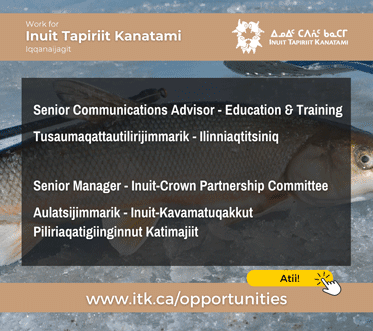Fear of contamination, lack of Inuktitut info turned Nunavik off uranium
“It is not possible to make an informed decision”

Kangiqsalujjuaq mayor Hilda Snowball and local landholding corporation president Willy Annanack address the BAPE uranium hearings Dec. 3. (PHOTO COURTESY OF MAKIVIK CORP)
Nunavik Inuit cannot support the development of uranium in the region — because of the risk of contamination and because they just don’t know enough about the controversial radioactive metal.
As the region’s leadership announced last week, Nunavik made its position on uranium mining official as the final round of Quebec hearings on the subject unfolded in Kuujjuaq Dec. 2 and Kangiqsualujjuaq Dec. 3.
In its Dec. 3 presentation to the independent Quebec body called the Bureau d’audiences publiques sur l’environnement, or BAPE, Makivik Corp. president Jobie Tukkiapik said the risk of uranium contaminating the local environment, including wildlife, was too great for Inuit.
That’s especially true given Nunavik’s reliance on country food, including migratory species such as caribou, he said.
“Uranium is radioactive and can harm wildlife,” Tukkiapik said in a Dec. 3 release. “The risk of contamination would cut us off from our traditional country foods. The negative impacts would be nungujuittuq, meaning something that will never perish.”
Tukkiapik told the hearing that people are also preoccupied by the absence of monitoring and intervention measures in relation to uranium exploration activities.
But in the end, the KRG and Makivik noted that Nunavik Inuit felt they couldn’t make an informed decision on the subject, given the lack of lack of information on the industry available in Inuktitut.
“Nunavimmiut want more communication from governmental bodies and the industry when it comes to uranium projects,” said the joint brief. “The efforts of the BAPE and the Kativik Environmental Advisory Committee are appreciated, however the information provided was not satisfactory.
“Until much more is known about the uranium industry and the information provided to Nunavik Inuit in a comprehensible way, in their language, it is not possible to make an informed decision.”
The brief also noted that Nunavik has a unique climate — immense watersheds, migratory wildlife resources and permafrost — making it difficult to compare to other regions where uranium is mined and processed.
It’s not clear what legal weight Nunavik’s position may hold.
As the BAPE’s cross-Quebec hearings wrap up mid-December, the commentary gathered from across the province will be compiled into a report.
The BAPE will then deliver that report to Quebec’s department of sustainable development, environment and the fight against climate change — le ministère du Développement durable, de l’Environnement et de la Lutte contre les changements climatiques — by May 2015.
There is no push to start mining uranium in Nunavik any time soon, although there are several hundred “mineralized occurrences,” or identified deposits, of uranium throughout the region.
Most are clustered around George River, including Azimut’s two early-stage exploration projects on its Rae North and Daniel Lake properties, southeast of the Ungava Bay community of Kangiqsualujjuaq.
A few uranium deposits have also been identified in central Nunavik and near the eastern Hudson Bay community of Umiujaq.
But in the brief’s conclusion, the KRG and Makivik add that Quebec and its citizens would be better served by promoting energy production from more renewable resources, such as hydroelectricity, tidal bores and wind power.





(0) Comments